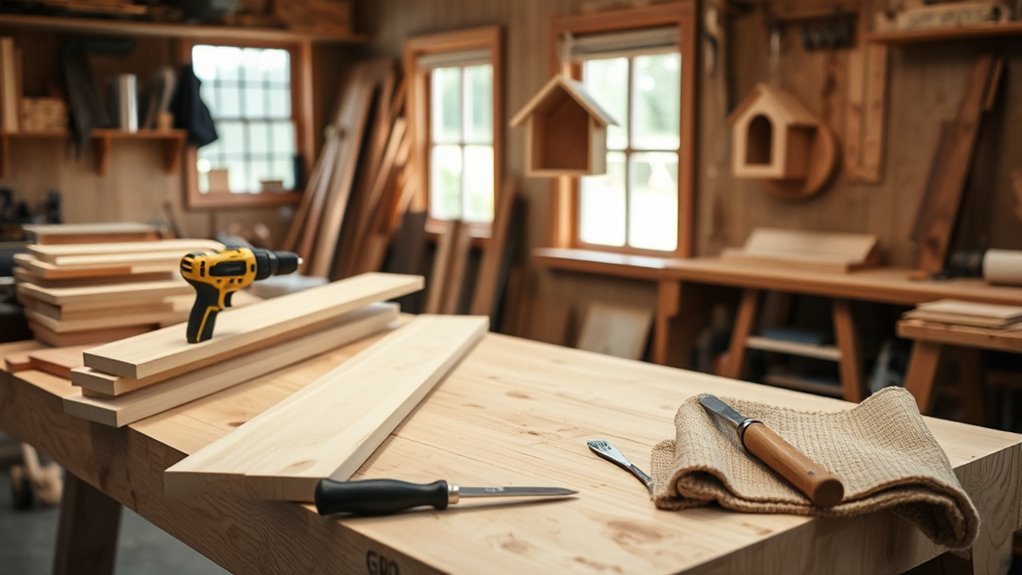Starting woodworking is exciting and rewarding. You’ll want to learn about basic tools like drills, saws, and hammers, and always follow safety rules such as wearing goggles and masks. Focus on simple techniques like butt joints and sanding to build your skills. Choosing the right wood and starting with small projects helps you gain confidence. Keep practicing patiently, and as you progress, you’ll enhance your skills and create even better pieces. If you continue exploring, you’ll discover more ways to improve.
Key Takeaways
- Start with basic hand tools and simple projects to build foundational skills safely.
- Prioritize safety by wearing protective gear and maintaining a clean, well-lit workspace.
- Learn proper techniques for measuring, cutting, and joining wood for accuracy and durability.
- Choose appropriate wood materials based on project needs, considering grain, strength, and drying quality.
- Practice patience, embrace mistakes as learning opportunities, and gradually expand your toolset and project complexity.
Essential Tools for Beginners

Starting with the right tools is essential for any beginner in woodworking. You’ll need a good mix of power tools and hand tools to get started. Power tools like a drill, jigsaw, and orbital sander make tasks faster and easier, especially when cutting or shaping wood. Hand tools such as a tape measure, chisel, claw hammer, and screwdrivers are equally important for precision and fine work. Investing in quality tools guarantees safety and better results as you learn. Beginning with essential hand tools helps establish a solid foundation for your projects. Using the right tools not only improves the quality of your work but also reduces frustration and potential injuries. Building your collection gradually allows you to develop confidence and skill without feeling overwhelmed. As you progress, you can expand your collection. Remember, mastering the right tools helps you work efficiently and enjoy the craft from the very beginning. Developing a solid foundation in essential tools is key to long-term success in woodworking.
Safety Practices Every Woodworker Should Know
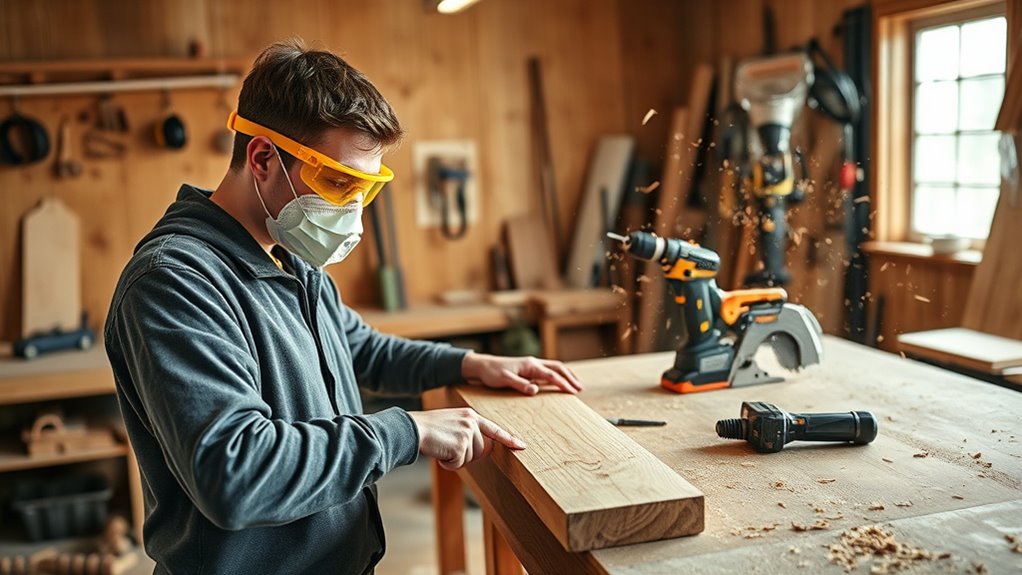
To work safely in woodworking, you need to understand and follow essential safety practices at all times. Wearing proper safety gear, such as goggles, ear protection, and dust masks, helps prevent injuries and promotes accident prevention. Always keep your workspace clean and well-lit to avoid slips or mishaps. Use tools correctly and never bypass safety features. Stay alert, avoid distractions, and take regular breaks to maintain focus. The table below highlights key safety practices:
| Safety Gear | Accident Prevention | Best Practices |
|---|---|---|
| Goggles and masks | Keep tools in good condition | Read manuals before use |
| Ear protection | Keep workspace tidy | Never work under influence |
| Dust masks | Maintain proper posture | Use push sticks for cuts |
Following these practices keeps your woodworking safe and enjoyable. Additionally, proper tool maintenance ensures safety and efficiency during projects. Being aware of potential hazards like dust exposure and managing them appropriately further enhances safety. For example, using projectors with high contrast ratios can improve viewing clarity in home cinema setups, reducing eye strain and enhancing the overall experience.
Basic Techniques and Joints
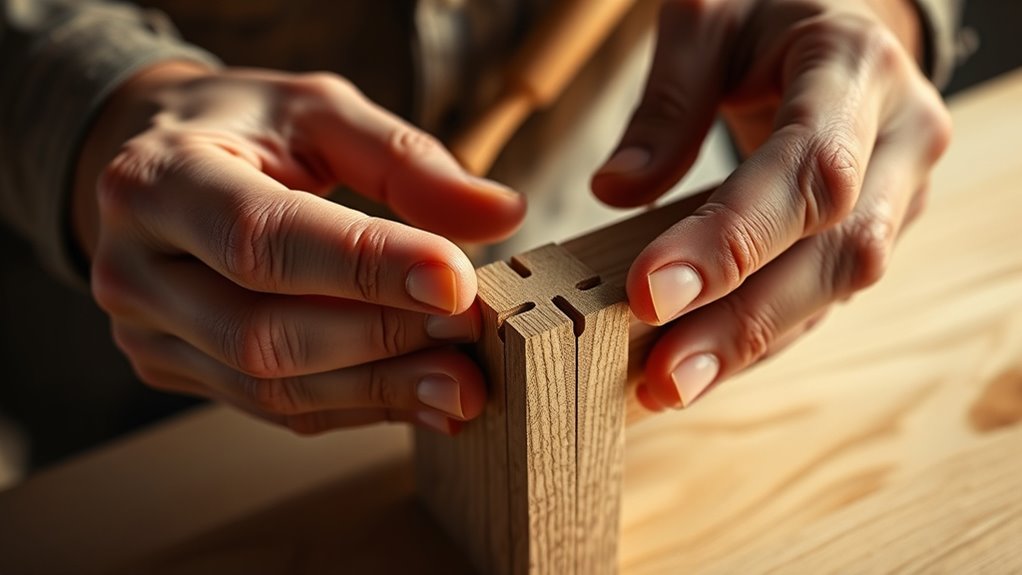
Mastering basic techniques and joints is essential for creating strong, durable woodworking projects. Focus on simple joinery techniques like butt joints, dado joints, and mortise and tenon joints to ensure your pieces come together securely. Practice proper sawing, planing, and sanding to achieve smooth, accurate surfaces. These foundational skills build a solid base for your projects. Once assembled, explore finishing methods such as staining, sealing, or applying varnish to enhance durability and appearance. Using the right joinery techniques guarantees your furniture holds together well over time, while effective finishing methods improve both look and longevity. Developing an understanding of wood selection can also inspire creative decorative touches in your woodworking projects. Additionally, paying attention to float mounting textile art techniques can help you incorporate unique decorative elements into your woodworking designs. As you develop these skills, you’ll gain confidence and produce higher-quality work with each project.
Choosing the Right Wood and Materials

When selecting wood, consider the different types and qualities to match your project’s needs. Think about the strength, grain, and durability of each material before making a choice. Using the right materials from the start helps guarantee your project turns out strong and looks great. Additionally, understanding material selection can help you optimize your project’s success and longevity. As automation advances, choosing materials that are compatible with automated tools can further improve efficiency and precision in your woodworking process.
Wood Types and Qualities
Choosing the right wood is essential for the success of your woodworking projects, as different types offer varying strengths, appearances, and workability. When selecting wood, pay attention to the wood grain, which influences both the look and how easily you can shape the material. Straight grain typically results in stronger, more stable pieces, while irregular grain can add character but may be harder to work with. Consider how the wood responds to wood treatment methods, such as staining or sealing, to ensure your finished piece looks professional. Hardwoods like oak and maple are durable and ideal for furniture, while softwoods like pine are easier to work with for beginner projects. Matching the wood’s qualities to your project’s needs will help you achieve better results. Additionally, understanding the grain structure of the wood can help you select pieces that are less prone to warping or splitting over time. To make informed choices, it’s also helpful to familiarize yourself with wood treatment methods, which can enhance the durability and appearance of your projects.
Material Selection Tips
Selecting the right wood and materials is vital for guaranteeing your project turns out well. Pay attention to grain patterns, as they affect both appearance and strength. Consistent grain reduces warping and splitting over time. Checking moisture content is imperative; wood with high moisture can warp or crack as it dries. Choose properly dried, stable wood to guarantee a smooth finish. Ensuring your wood complies with wood stove safety standards can prevent future hazards and ensure safety during your project. Additionally, understanding creative practice can help you develop better techniques for selecting and working with different materials. Properly managing wood properties can significantly influence your project’s success. – Consider grain direction to enhance durability and aesthetics – Confirm moisture content is appropriate for your climate and project – Select wood with uniform grain patterns for a professional look – Avoid woods with irregular grain or excessive knots that may weaken the piece
Simple Projects to Get Started
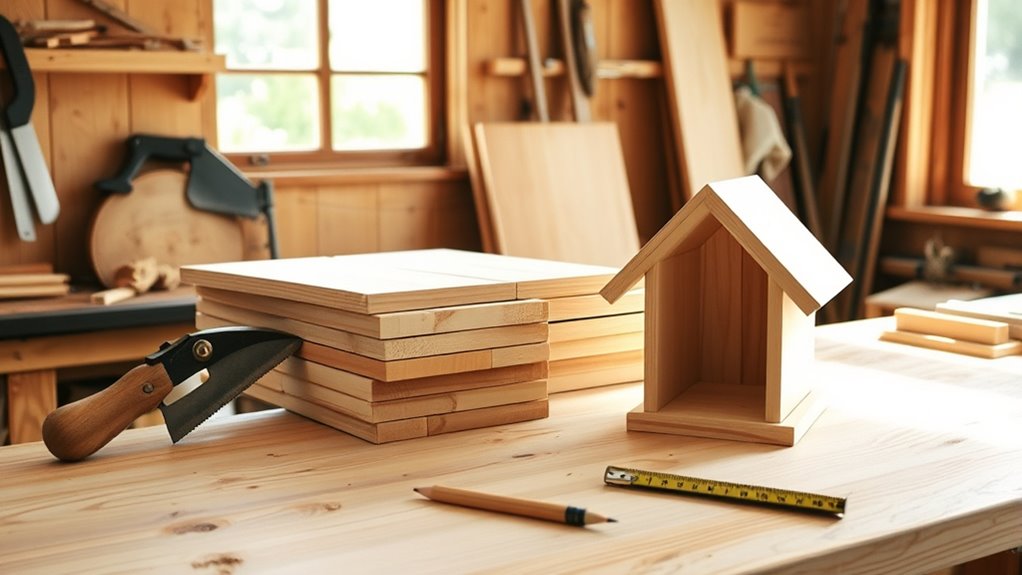
Getting started with woodworking is easier than you might think, especially when you choose simple projects that build your skills and confidence. Start with basic items like a wooden picture frame or a small shelf, which teach you essential techniques like cutting, sanding, and assembling. As you progress, focus on furniture assembly projects such as a stool or a side table, which introduce you to joinery and structural stability. These projects also give you a chance to experiment with decorative finishes, adding personal style and professionalism to your work. Completing straightforward projects helps you develop good habits, understand tools, and build your confidence. Additionally, selecting appropriate tools is crucial for achieving quality results and safe working conditions. Knowing regional resources can also help you access expert advice and supplies when needed. Moreover, exploring cultural heritage related to woodworking traditions can inspire your projects and deepen your appreciation for craftsmanship. Keep your projects simple, practice patience, and enjoy the process of turning raw wood into functional, attractive pieces.
Tips for Developing Your Skills Over Time
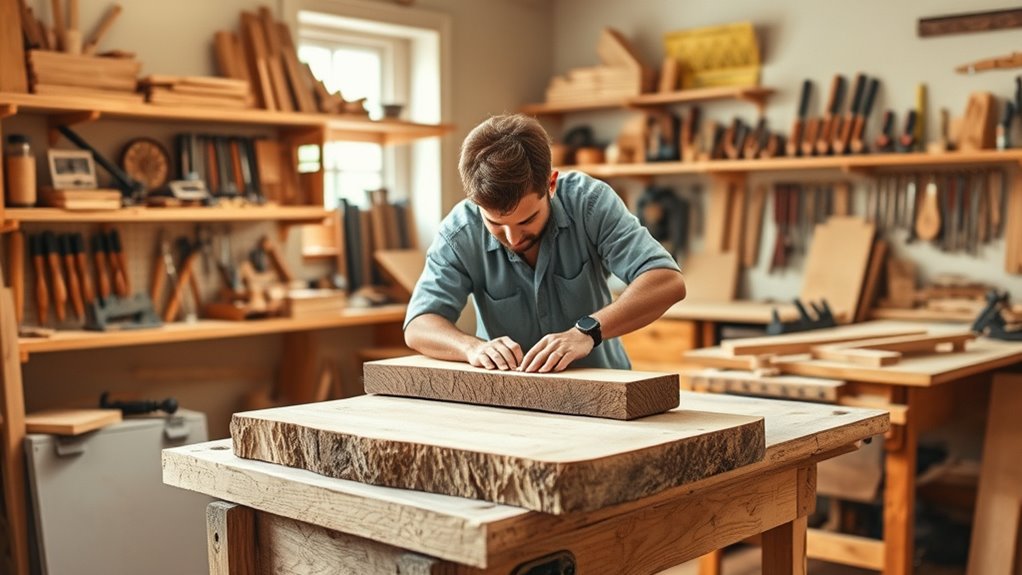
To improve your woodworking skills, practice consistently and stay patient with your progress. Don’t be afraid to learn from your mistakes—they’re valuable lessons. As you gain confidence, expanding your toolset will open up more creative possibilities.
Practice Regularly and Patience
Practicing woodworking consistently is essential for building your skills and confidence. Over time, patience becomes your best tool, helping you stay motivated even when projects challenge you. Developing consistency in your practice means dedicating regular time to learn new techniques and refine your craftsmanship. Remember, progress may be slow at first, but persistence pays off. To strengthen your skills, keep these ideas in mind: application timing for pimple patches can also be applied to scheduling practice sessions to maximize effectiveness. Incorporating building a routine ensures steady progress and helps reinforce good habits. Maintaining a positive mindset can also boost your learning efficiency during practice sessions. Embracing growth mindset encourages resilience and helps you view setbacks as opportunities to improve. Practice patience during frustrating moments to avoid burnout. Set small, achievable goals to track your progress. Embrace mistakes as learning opportunities. Maintain a routine to build steady improvement.
Learn From Mistakes
As you continue practicing woodworking, you’ll inevitably encounter mistakes—some small, others more significant. These are part of the learning process, helping you recognize common pitfalls and improve your skills. Don’t get discouraged by errors; instead, view them as valuable lessons. Every mistake reveals areas for growth and allows you to refine techniques. Remember that learning curves can be steep at first, but persistence pays off. Keep a mental note of what went wrong and how to fix it for next time. Patience and a willingness to learn from mistakes will accelerate your progress. Over time, you’ll gain confidence and develop a sharper eye for detail, making your projects more accurate and rewarding. Mistakes are simply stepping stones toward mastery. Additionally, understanding drivetrain components and how they function can help prevent issues and improve your overall craftsmanship. Developing a good understanding of common woodworking tools can also reduce errors and improve safety during your projects. Familiarity with safety procedures is equally important to avoid accidents and ensure a smooth learning journey. Cultivating mindfulness and emotional intelligence can help you stay focused and calm when troubleshooting mistakes, leading to better problem-solving and a more enjoyable woodworking experience.
Expand Your Toolset
Expanding your toolset is essential for progressing in woodworking, as having a diverse range of tools allows you to tackle more complex projects and refine your techniques. Investing in both power tools and hand tools helps you work efficiently and accurately. As you develop your skills, consider adding tools like a jigsaw, router, or chisels to your collection. These broaden your capabilities and open new creative possibilities. Remember, mastering different tools improves your craftsmanship and confidence. Keep learning about their uses, maintenance, and safety. Building your toolkit gradually ensures you develop a strong foundation. Over time, your ability to execute intricate designs and handle challenging projects will grow, making woodworking more enjoyable and rewarding.
- Understand each tool’s purpose and limitations
- Practice proper safety and maintenance
- Balance power tools with traditional hand tools
- Grow your toolkit based on project needs
Frequently Asked Questions
How Do I Choose the Right Woodworking Classes or Tutorials?
When choosing woodworking classes or tutorials, you should consider your skill level and focus on tool selection. If you’re a beginner, look for courses that start with basic skills and introduce essential tools gradually. For more advanced learners, seek tutorials that challenge your current abilities and cover specialized tools. Always read reviews and course descriptions to guarantee they match your goals, so you gain confidence and improve efficiently.
What Are Common Mistakes Beginners Make in Woodworking?
When starting out, you often make mistakes like ignoring safety precautions and rushing measuring accuracy. You might skip wearing safety gear or not double-check measurements, leading to errors or injuries. To prevent this, always follow safety precautions, such as wearing goggles and gloves, and take your time measuring twice. These habits ensure your projects are precise and safe, helping you build confidence and skill in woodworking.
How Do I Maintain and Care for My Woodworking Tools?
Think of your woodworking tools as a garden needing regular care. You should sharpen your tools frequently to keep them cutting smoothly, like trimming dead branches. Clean and dry your tools after use to prevent rust and apply rust prevention oil when storing for long periods. Proper maintenance guarantees your tools stay sharp, durable, and ready for your next project, making woodworking safer and more enjoyable.
What Are Budget-Friendly Options for Starting Woodworking?
If you’re starting woodworking on a budget, look for affordable tools like basic saws, drills, and sanders that meet your needs. You can also create DIY storage solutions using repurposed materials to keep your workspace organized without extra costs. Focus on quality within your budget, and gradually upgrade as you gain experience. This way, you build a solid foundation without overspending, making woodworking enjoyable and accessible from the start.
How Can I Find Inspiration for New Woodworking Projects?
You might worry about running out of creative project ideas, but there’s plenty of woodworking inspiration sources out there. Explore online platforms like Pinterest and Instagram for fresh ideas, or visit local craft fairs to see unique projects. Keep a notebook of your favorite designs, and don’t hesitate to experiment with different styles. With curiosity and a bit of research, you’ll find endless woodworking inspiration sources to spark your next project.
Conclusion
Now that you’ve got the basics down, you’re ready to carve your own path in woodworking. Remember, patience and practice are your best tools—think of it like tending a trusty steed in a bustling marketplace. Keep safety in mind, start small, and enjoy every step of the journey. Before you know it, you’ll be creating masterpieces that even Leonardo da Vinci would admire in his workshop. Happy carving!
